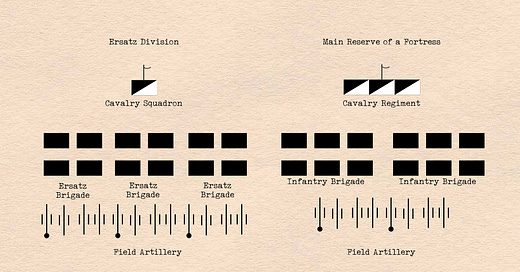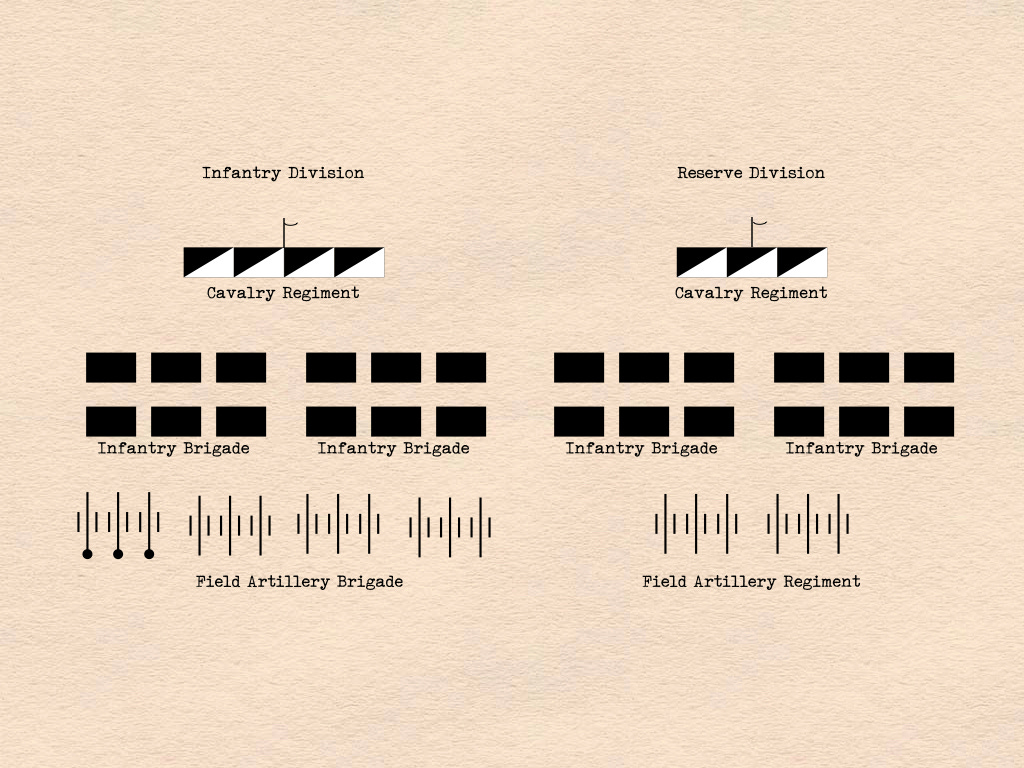The evolution of German infantry divisions during the first half of World War I is, in many respects, similar to the development of their British counterparts. At the start of the war, both the British and German armies rushed to create a large number of improvised formations. As these had to be assembled from resources at hand, the particular shape that these formations took was of much less importance than the rapidity with which they could be sent into action.
The result was a degree of organizational diversity that, in addition to violating the aesthetic sensibilities of many professional soldiers, greatly complicated the chief business of higher headquarters: shifting formations from one place to another, providing supplies and reinforcements, responding to operational emergencies and laying the groundwork for great battles. Because of these difficulties, the senior leadership of both armies took pains to impose a single organizational scheme upon their infantry divisions.
By the end of the first year of the war, the British Army was well on its way to accomplishing this goal. While there were still considerable differences in the internal structure of field artillery units, the overall strength of the artillery establishments of most divisions had been equalized. The German Army, however, followed a different schedule. The first anniversary of the mobilization of 1914 found it at the very start of the long struggle to rationalize the structure of its infantry divisions. Just how difficult this effort would be can be seen in the simple fact that the German Army of the summer of 1915 had nine standard types of infantry division as well as more than a dozen formations that were entirely sui generis.1
At the very start of the war, what little variety there was in the organizational structure of German infantry divisions lay in the realm of field artillery. An active infantry division (known simply as an Infanterie Division) was invariably provided with twelve battalions of infantry and twelve batteries of field artillery. A Reserve division (Reserve Division) usually had twelve battalions of infantry and six batteries of field artillery.2
Within three weeks of mobilization, this relatively neat arrangement was profoundly disturbed by the appearance of a number of improvised formations. The creation of nine of these divisions, the six Ersatz divisions and the three divisions that formed the main reserve forces [Hauptreserven] of large fortresses, had been foreseen before the war.3 The assembly of the rest, however, was a reaction to the Russian invasion of East Prussia. As might be expected, the organizational structures of “main reserve of a fortress” and Ersatz divisions were more consistent than those of the ad hoc formations. Nevertheless, the patterns providing this consistency were substantially different from those used to shape the divisions that had been originally assigned to field armies.4
The six Ersatz divisions were formed in the middle of August 1914 by assembling eighteen mixed Ersatz brigades [gemischte Ersatz Brigaden] into groups of three. Each of these mixed Ersatz brigades had been a small formation in its own right, with four battalions of infantry, four batteries of field artillery, and a troop of horse cavalry.5 The Ersatz divisions might thus be seen as organizations comparable to contemporary Belgian divisions d’armée, formations that were neither conventional infantry divisions nor traditional army corps.
The way in which the field artillery batteries of Ersatz divisions were assembled into larger units was also peculiar. Standard field artillery groups [Abteilungen] of the German Army invariably consisted of three batteries. Those of Ersatz divisions had but two. Most German field artillery groups were uniformly armed with either field guns or light field howitzers. Half of the field artillery groups of Ersatz divisions, however, consisted of one battery of field guns and one battery of light field howitzers.
There was no tactical rationale for the peculiar organization of Ersatz formations. Rather, the odd structure of Ersatz brigades and divisions was an artifact of the German mobilization system. The depots of a typical peacetime infantry brigade mobilized a complete Ersatz infantry battalion. Sometimes called a “brigade Ersatz battalion” [Brigade Ersatz Bataillon], this battalion bore the same number as the peacetime brigade that created it. At the same time, the depots of a peacetime field artillery brigades usually mobilized two Ersatz batteries. Thus, as most peacetime army corps each consisted of four peacetime infantry brigades and two peacetime field artillery brigades, the Ersatz brigades they mobilized each took the field with four infantry battalions and four field artillery batteries. Similarly, the two peacetime army corps that possessed five peacetime infantry brigades created Ersatz brigades with five infantry battalions.6
The Reserve divisions assigned to the fortress complexes of Metz, Strassburg, and Thorn combined features of conventional Reserve infantry divisions with those of Ersatz formations. On the one hand, the infantry establishments consisted of two or three infantry brigades.7 On the other hand, their field artillery consisted of Ersatz batteries that, like the batteries of Ersatz formations, were formed into two-battery groups.8
As was the case with Ersatz formations, the structure of the “main reserve of a fortress” Reserve divisions was more the by-product of the German mobilization system than the fruit of unfettered design. In particular, the decision to provide field artillery in the form of four two-battery Ersatz groups seems to have reflected nothing more than the fact that it was easier for the depots of the artillery regiments in question to create two Ersatz batteries than three Reserve batteries.
The improvised divisions created on the Eastern Front were cobbled together from whatever units were at hand. The four chief sources for these units were the mixed brigades of the Landwehr; individual battalions, batteries, and squadrons of the Landsturm; regimental depots; and the garrisons of fortresses. (The latter included a variety of Landwehr and Landsturm units, as well as machine gun, pioneer and heavy artillery units of the active army.)
Unless otherwise indicated, descriptions of German units and formations were derived from the detailed order of battle appended to the first volume of the German official history of World War I. Germany, Reichsarchiv, Der Weltkrieg, (Berlin: E.S. Mittler und Sohn, 1925-1956), I, pages 664-687.
Most Reserve divisions were provided with six field artillery batteries, all of which were equipped with field guns. Four Reserve divisions, however, took the field with larger artillery establishments. The 23rd and 24th Reserve Divisions were each provided with nine field gun batteries. The 26th Reserve Division had six batteries of field guns and three of light howitzers. The 1st Guard Reserve Division had the same artillery establishment as an active division.
When capitalized and written in italic type, the word Reserve is a term of art that refers to units and formations of a particular category.
Though formed on a different pattern, the divisions that provided the “main reserve of a fortress’ were numbered in the same series as the Reserve divisions formed for service with armies in the field. Thus, the “main reserve of the fortress of Metz” (Hauptreserve der Festung Metz) was also known as the 33. Reserve Division.
Six Ersatz divisions were formed in 1914: the Guard Ersatz Division, the 4th Ersatz Division, the 8th Ersatz Division, the 10th Ersatz Division, the 19th Ersatz Division and the Bavarian Ersatz Division. For a detailed description of the formation of mobile Ersatz units, see Bavaria, Heeresarchiv, Die Schlacht in Lothringen und in den Vosegen, die Feuertaufe der Bayerischen Armee, (Munich: M. Schick, 1929), I, pages 1-33.
Two of the eighteen mixed Ersatz brigades formed into divisions in August 1914 had five infantry battalions rather than four. The one Ersatz brigade that escaped being incorporated into a division in 1914 (55. gemischte Ersatz Brigade) had six infantry battalions. All told, 19 (out of 25) peacetime army corps, 86 (out of 109) peacetime infantry brigades and 44 (out of 50) peacetime field artillery brigades mobilized mobile Ersatz organizations. As might be expected, army corps and peacetime brigades that had been formed recently were less likely than their older counterparts to form affiliated Ersatz organizations. Hermann Cron, Geschichte des Deutschen Heeres im Weltkrieg, (Berlin: Karl Sigismund, 1937), pages 119 and 144
The infantry of the Hauptreserve of Metz consisted of one Reserve infantry brigade and one active infantry brigade. That of Straßburg had three Reserve infantry brigades. The two infantry brigades of the main reserve of Thorn were both Landwehr infantry brigades.
The field artillery establishments of the Hauptreserven of Metz and Strassburg each consisted of eight Ersatz batteries, which were formed, two-by-two, into four Ersatz Abteilungen. The field artillery of the main reserve of Thorn, with two two-battery Ersatz groups, was much smaller.







Some Questions and Statements about Ersatz and MG units.
-
Q1. When the Ersatz brigades joined their division, did they lose control of their non-infantry units, or did they act as permanent Combined Arms formations?
-
Q1.5. If they lost control of the non-inf units, were the newly-divisional units combined under a higher HQ, or did the Divisional Commander have to deal with a dozen independent units?
-
Q2. Have you been able to find any reliable sources on the allocation of MGs in Ersatz Brigades? Cron's book presents many wildly different options, ranging from 2 Platoons to 2 Battalions per (which I believe is due to the overuse of the term Abteilung in the German Armies and translation errors with the term). After analysis and further (mostly fruitless) research online, I believe that the most likely answer is that around half of the Brigade-Ersatz-Battalions raised a 2-gun Platoon, meaning that, on average, each Ersatz Brigade had 4 MGs.
-
S1. Most Ersatz Brigades had a pioneer company, which meant that the Ersatz divisions had the highest concentration of pioneers among the initial divisions (and the 1st-4th series divisions later on).
-
S2. Around 33% of Reserve Infantry Regiments and all Landwehr Regiments had no MG Company, but that was remedied relatively quickly as hundreds of MG units were raised. See Q2. for discussion on MG units in Ersatz Brigades.
-
Source: the aforementioned Cron book